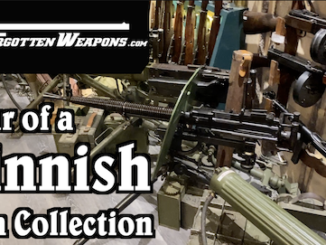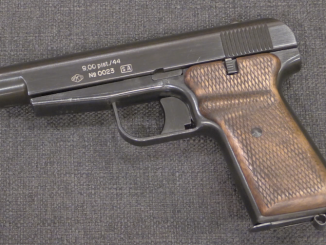A montage of a bunch of shooting from my trip to Finland in June 2017! Including:
- m/31 Suomi
- KP-44
- KvKK-62
- LS-26
- DP-28 (Emma)
- M91/24, M27, and M28/30 Mosins
- M32/33 Maxim
- Rk-95
- Sako TRG in 7.62mm NATO
Thanks to Varusteleka.com for arranging this shooting trip!




What? No Tkiv 85? Sigh!
What a shootout; lots of powder burned…. 🙂
What was the first SMG? It looked like Sudayev PPS-43 with substitute magazine.
“It looked like Sudayev PPS-43”
KP m/44: https://en.wikipedia.org/wiki/KP_m/44_submachine_gun
“substitute magazine”
It fires 9×19 mm Parabellum cartridge
“KP-44”
After reading query in Wikipedia:
https://en.wikipedia.org/wiki/KP_m/44_submachine_gun
I am quite confused about magazines used, as I understand there was magazine compatibility between SUOMI and KP m/44. According to data from link, there existed following magazines: 20, 50, and 36-round detachable box magazines, 40 and 71-round drum magazines
Which one was default for KP m/44? Were drum magazines used with KP m/44? How it affected ergonomic?
KP M/44 was not used in WW2 and even after the war it was not commonly used for training, but the “default” magazines would have been the same as for the M/31 Suomi, namely either the 50 round quadruple row box magazine or the 70-round drum magazine until mid-1950s when the 36-round magazine replaced all other box magazines. After that the standard magazines for both SMGs were the 70-round drum and 36-round box and the older magazines were eventually disposed of.
The 20-round box magazines and 40-round drums were the oldest ones and as the wore down they were used increasingly less already during the war with the Suomi. By 1945 most if not all had been replaced by newer magazines. So, in theory they could have been used with the M/44, but that would have been quite unlikely.
“until mid-1950s when the 36-round magazine replaced all other box magazines”
So in fact in end they returned to very beginning – as PPS has magazine for 35 rounds.
The 36-round magazine was adopted from Swedish Carl Gustav M/45 (Kpist m/45). The 50-round box was not very reliable and the 70-round drum was expensive, so something cheaper to replace the former was needed. The Swedish 36-round one was both inexpensive and extremely reliable
“M/31 Suomi”
Wait. I now realized something. SUOMI mean Finland in Suomi.
This is only one known for me of fire-arm named same as country where it was manufacturer – though Le Français and more recent (and ill-famed) All American 2000 might be considered similar cases, but bear same name as citizen, not country.
Was there any other case of naming fire-arm same as country where it was manufactured?
Was the problem with the Mosin Nagant bolt with the gun or the ammo?
I’m positively salivating over that Rk 95, you lucky dog.
I’m positively salivating over the “Tin-Henry” pelki-kp/ pelki-heikki 9mm SMG clone of the Sudayev PPS43 and the Suomi m/31 kp… Although I think I might like the Swedish m/37-39 with shorter barrel even more!
Ian and Karl, you dogs!, this is some seriously awesome montage vicarious thrill footage here! I was very interested in the Mosin-Nagant footage–since of all the Finnish small arms you got to shoot, that’s all I have! Also the MG footage. Admirable fire discipline guys!
Kiitos to Varusteleka for making it all happen! And in (mostly) period correct uniforms! Y’all really are some lucky dogs!
Is something going on with the Mosins?
It looks so awkward and violent when the bolt is operated.
Is it really supposed to be like that?
The Mosin-Nagant rifle bolt is pretty “cludgy” in my experience. Ol’ Karl there is doing the sort of “karate chop” to close it. The Mosin-Nagant can often be operated–*from the shoulder*–depending on a person’s build. The butt remains in the shooter’s shoulder pocket, the right hand grasps the bolt, palm up, and the support hand cants the rifle over to the right a bit against the opening motion of the bolt. Shooting from the prone position, I find my arms are too short to operate from the shoulder. So I have to do the other, slower technique: The firing hand pulls back the cocking knob until the bolt is cocked. The thumb goes against the rear surface of the knob, while the two fingers of the firing hand go under the bolt handle and push it up 90 degrees to the open position. Then the two fingers rejoin the thumb, and pull the entire bolt back past the firer’s cheek using the cocking knob as a handle. As the bolt is returned to battery, stripping a cartridge from the magazine and inserting it into the chamber, the two fingers leave the knob again, turn the bolt handle down to lock, and then go back to resumption of the firing grip.
Not only does the latter, slower technique also appear in the Soviet manuals (I’ve never had the privilege of seeing a Finnish manual), but there is even film footage of it.
Ok.
Do you mean that it could be easier to cock the bolt as a separate action in addition to operating the bolt (to feed a new cartridge)?
Is it a cock on close or cock on open action if you don’t?
Basically, yes. A single hand can operate the bolt in a single stage: Open the bolt, extract and eject the empty case while cocking the striker, then close the bolt, chambering a cartridge and locking the action. Or as a double stage: Cock the striker first, then manipulate the bolt for the normal order of operates with much less tension and friction, but also more slowly.
The Mosin-Nagant bolt design is a cock-on-opening design.
Joseph E. Smith, _Small Arms of the World_ 10th ed. pp. 578-580:
” The two locking lugs [of the bolt, in a separate bolt-head) engage horizontally in the receiver, the opposite of most types. The bolt head turns with the bolt [basically, the bolt handle is turned by hand, which in turn operates a small lug on the bolt head… Think of it as a bolt action turning another tiny bolt action, if you will…) …
A special connecting bar joins the bolt head to the bolt itself. This bar does not turn with the bolt; it is positioned in the underside of the bolt assembly and and lies in a receiver cut in the boltway. This bar also acts as a guide for the cocking piece, and assists in keeping the bolt securely in the receiver. The bar has a projection rising from its forward end. This projection holds a small hollow cylinder. The rear end of this cylinder rests in the hollow front of the bolt, while the forward end of the cylinder nests in the rear of the bolt head. …
A small lug on the front end of the connecting bar fits into a groove inside the bolt head, and a small lug on the rear of the bolt head catches in a recess at the front end of the bolt extension rib. Thus as the bolt turns the bolt head is compelled to turn with it. …
Lifting bolt handle rotates bolt, bolt head, and extractor as a unit. A cam cut at the rear of the bolt forces against the cocking nose on the underside of the cocking piece [i.e. the “cocking knob” which is screwed to the firing pin and mainspring]. The cocking piece and striker assembly are forced back, thereby pulling the firing pin point back away from the primer. The mainspring is partly compressed.
The rib extending forward from the bolt proper passes along a special cam surface on the toop of the overhanging receiver ring. (The bolt head is entirely enclosed by the receiver ring.) This action forces the entire bolt assembly back to to give primary extraction,the rearward thrust beginning as soon as the bolt has turned far enough for the locking lugs on the bolt head to clear their seats in the receiver ring.
The turning bolt operates the interrupter … [to prevent “rim lock” from the cartridges in the magazine]… The short extractor in the bolt head carries the empty case back and strikes it against the ejector. …